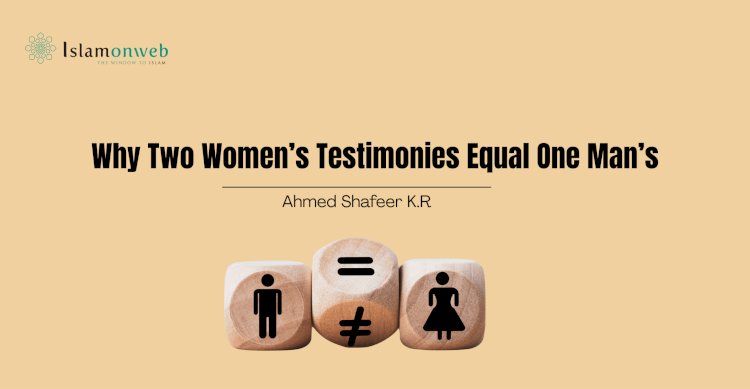Why Two Women’s Testimonies Equal One Man’s: A Contextual and Theological Analysis
The Qur’ānic principle that, in certain legal contexts, the testimony of two women is equal to that of one man has long been a topic of discussion, often evoking controversy among scholars, feminists, and critics of Islamic law. This issue is frequently misunderstood and misrepresented as a blanket statement about gender inequality in Islam. However, a contextual and theological exploration reveals a far more nuanced reality. Rooted in a specific legal setting, this principle is not an absolute rule applied universally across all areas of Islamic law. Rather, it emerges from the Qur’ān’s response to the socio-legal norms of 7th-century Arabia and its intent to reform and uplift a society with entrenched inequities. Through a close reading of the relevant verse, an understanding of its historical and linguistic background, and a broader reflection on Islamic ethical principles, this analysis aims to demonstrate that the ruling reflects practical considerations rather than a diminished view of women’s credibility or intellect.
Qur’ānic Foundation and Historical Context
The foundational reference for the ruling regarding two women’s testimony equating to that of one man in certain legal contexts comes from Sūrat al-Baqarah (2:282)—the longest verse in the Qur’ān, which outlines detailed protocols for documenting debts:
وَٱسْتَشْهِدُوا۟ شَهِيدَيْنِ مِن رِّجَالِكُمْ ۖ فَإِن لَّمْ يَكُونَا رَجُلَيْنِ فَرَجُلٌۭ وَٱمْرَأَتَانِ مِمَّن تَرْضَوْنَ مِنَ ٱلشُّهَدَآءِ أَن تَضِلَّ إِحْدَىٰهُمَا فَتُذَكِّرَ إِحْدَىٰهُمَا ٱلْأُخْرَىٰ
“And bring to witness two witnesses from among your men. And if there are not two men [available], then a man and two women from those whom you accept as witnesses—so that if one of the women errs, then the other can remind her.” (Qur’ān 2:282)
This verse specifically pertains to financial transactions (muʿāmalāt), a domain overwhelmingly dominated by men in pre-Islamic Arabia. At that time, women were rarely involved in commerce, had little to no legal representation, and were often treated as dependents or property rather than autonomous individuals. By formally including women in legal procedures—as witnesses, even if with a correction mechanism—the Qur’ān introduced a revolutionary shift. It granted women legal visibility and participation in a public sphere previously closed to them.
Many misinterpret this verse as an implicit assertion that women are intellectually inferior or naturally more forgetful than men. However, a contextual analysis shows that this is not a comment on women's capacity but rather a precautionary measure rooted in social realities of the time. The stipulation of "a man and two women" is confined to a specific legal context: financial transactions. These dealings required familiarity with legal and commercial practices, areas from which most women of the era were excluded due to widespread illiteracy and social marginalisation.
According to Tafsīr al-Miṣbāḥ and scholars like K.H. Zaitunah Subhan (Tafsir Kebencian), the provision is not about female deficiency but about safeguarding accuracy in a context where women, by no fault of their own, were less experienced. The term taḍillu (تَضِلَّ) in the verse, meaning to err or forget, is addressed with the clause fa-tudhakkira iḥdāhumā al-ukhrā (فَتُذَكِّرَ إِحْدَىٰهُمَا ٱلْأُخْرَىٰ), meaning “then the other can remind her.” This clause affirms that the second woman’s role is not to offer independent testimony, but to support the memory of her peer—ensuring the reliability of the evidence.
Therefore, the ruling is not a reflection of ontological differences between genders but a practical accommodation. The Qur’ān’s directive was intended to avoid gaps in legal testimony stemming from social inequalities—not to encode those inequalities into divine law. On the contrary, this inclusion marked a step forward in giving women access to the legal process, empowering them through gradual integration into public affairs.
The Role of the Second Woman: A Supportive Mechanism
A central aspect of Sūrat al-Baqarah (2:282) is the function of the second woman in the witnessing process. The Qur’ān clarifies that her presence is intended “an taḍilla iḥdāhumā fa-tudhakkira iḥdāhumā al-ukhrā”—so that if one of the women errs or forgets, the other may remind her. This does not imply that women are inherently forgetful or unreliable. Rather, it acknowledges the practical reality that individuals with limited exposure to financial dealings may require support to ensure accuracy.
In the context of 7th-century Arabia, where women were systematically excluded from commerce and legal transactions, it was reasonable to assume that such support might be needed. The second woman’s role is thus a mechanism of reinforcement, not a reflection of ontological inferiority. It represents a practical safeguard, not a theological judgement about women's intellect or capacity.
Importantly, the Qur’ānic requirement for multiple witnesses is not exclusive to women. In fact, it appears in other legal contexts, reinforcing the principle that accuracy and justice often require corroboration, irrespective of gender. For example:
وَٱلَّذِينَ يَرْمُونَ ٱلْمُحْصَنَـٰتِ ثُمَّ لَمْ يَأْتُوا۟ بِأَرْبَعَةِ شُهَدَآءَ فَٱجْلِدُوهُمْ ثَمَـٰنِينَ جَلْدَةًۭ وَلَا تَقْبَلُوا۟ لَهُمْ شَهَـٰدَةً أَبَدًۭا ۚ وَأُو۟لَـٰٓئِكَ هُمُ ٱلْفَـٰسِقُونَ
“Those who accuse chaste women of adultery and fail to produce four witnesses—lash them with eighty lashes and do not accept their testimony ever again. Indeed, they are the rebellious.” (Qur’ān 24:4)
Here, the requirement of four witnesses in accusations of adultery serves not to discredit any individual’s testimony but to underscore the gravity of the charge and prevent false accusations. The principle, therefore, reflects a heightened threshold for evidence to uphold justice—not a gendered suspicion.
Furthermore, Islamic jurisprudence demonstrates flexibility in applying testimony based on domain-specific expertise. According to Imām al-Shaʿbī—a respected Tābiʿī (successor of the Companions)—women’s testimonies are given precedence in matters uniquely within their knowledge, such as childbirth or gynaecological issues. This position is echoed by scholars like Dr. Saʿīd Ramaḍān al-Būṭī, who notes that equity, not rigid uniformity, governs Islamic legal rulings (Yughālithūnaka idh yaqūlūn).
Thus, the Qur’ānic framework of witness testimony upholds justice through pragmatic and contextual guidelines. The involvement of an additional woman in financial testimonies is best understood not as a measure of inferiority, but as a corrective support system in a society transitioning toward greater inclusivity and legal integrity.
Linguistic and Grammatical Aspects
Arabic grammar plays a critical role in the interpretive nuances of Qur’ānic verses, and Sūrat al-Baqarah (2:282) is no exception. The verse employs the feminine form shāhidatān (شَاهِدَتَانِ) for “two female witnesses,” yet uses the masculine numeral shāhidayn (شهيدين) to quantify them. Classical commentators such as al-Zamakhsharī, in al-Kashshāf, noted that this reflects the prevailing male dominance in financial dealings during the era, not necessarily a theological assertion about gender roles.
However, contemporary scholar Muḥammad Quraish Shihāb provides a more contextualised linguistic reading. He argues that the Qur’ān’s use of shāhidayn in the context of female witnesses is not a grammatical oversight but a deliberate indication that the situation being described is an exception—restricted to debt contracts and not a general rule applied across all domains of testimony (Perempuan, M. Quraish Shihab). This linguistic specificity is crucial in refuting the notion that Islamic law universally devalues women’s testimony.
Indeed, the Qur’ān demonstrates flexibility in evidentiary principles in different legal contexts. For example, in cases of liʿān (mutual imprecation in accusations of adultery between spouses), the testimony of a single woman—or her oath—can overrule a man’s accusation:
وَيَدْرَؤُا۟ عَنْهَا ٱلْعَذَابَ أَن تَشْهَدَ أَرْبَعَ شَهَـٰدَٰتٍۢ بِٱللَّهِ ۙ إِنَّهُۥ لَمِنَ ٱلْكَـٰذِبِينَ وَٱلْخَـٰمِسَةَ أَنَّ غَضَبَ ٱللَّهِ عَلَيْهَآ إِن كَانَ مِنَ ٱلصَّـٰدِقِينَ
“…and the punishment shall be averted from her if she bears witness four times [swearing] by Allah that he is of the liars, and the fifth time that the wrath of Allah be upon her if he is telling the truth.” (Qur’ān 24:8–9)
This demonstrates that testimony rules in Islam are not fixed by gender but adapted according to context, subject matter, and the seriousness of the case.
Muḥammad ʿImārah offers a crucial distinction between shahādah (شَهَادَة)—formal testimony within a court—and ishhād (إِشْهَاد)—witnessing or attestation in non-court settings, such as documentation of contracts. He argues that Sūrat al-Baqarah 2:282 refers to ishhād, a procedural measure to ensure justice in documentation, not a definitive ruling on court testimony. In court settings, he maintains, the judge may accept or reject testimonies based on individual reliability (thiqa), not gender alone (al-Taḥrīr al-Islāmī li al-Mar’ah).
This interpretation aligns with Prophetic precedent. In Sunan Abī Dāwūd (2276), the Prophet ﷺ accepted a single woman’s claim in a case involving her son’s custody:
عن عبد الله بن عمرو قال:
"يا رسولَ اللهِ، إنَّ ابني هذا كان بطني له وعاءً، وثديي له سِقاءً، وحجري له حِواءً، وإنَّ أباه طلَّقني، وأراد أن ينتزعَه مني"، فقال لها رسول الله ﷺ: "أنتِ أحقُّ به ما لم تنكحي."
A woman said: O Messenger of Allah, this son of mine—my womb was a vessel for him, my breast a water-skin, and my lap a guard—his father has divorced me and now wishes to take him. The Prophet ﷺ said: You have more right to him, as long as you do not marry. (Sunan Abī Dāwūd 2276)
This ḥadīth affirms that women’s testimony, even when solitary, can be decisive and authoritative when rooted in direct experience or specific domains of knowledge. The Prophetic model prioritises justice, context, and trustworthiness over rigid gender norms, which further confirms the Qur’ān's commitment to equitable legal standards rather than absolute uniformity.
Psychological and Cognitive Views
Some classical scholars, such as Imām al-Shāfiʿī, interpreted the Qur’ānic verse on testimony literally and contextualised the need for two women witnesses in financial matters as a safeguard due to what they termed the "emotional nature" of women.
Modern cognitive psychology offers nuanced perspectives that align with the Qur’ān’s pragmatic wisdom rather than notions of intellectual deficiency. Research in cognitive science suggests that men and women exhibit differences in cognitive strengths—not in intelligence per se, but in the ways memory, perception, and problem-solving are typically processed. For instance, men tend to perform better in spatial awareness and mathematical tasks, while women often show greater proficiency in verbal memory, emotional intelligence, and social cognition.
These differences are not absolute, nor are they indicative of superiority or inferiority. Instead, they reflect complementary faculties within the broader spectrum of human cognition. When seen through this lens, the Qur’ān’s instruction in Sūrat al-Baqarah (2:282)—to include a second woman as a reminder (fa-tudhakkira iḥdāhumā al-ukhrā)—can be interpreted as a pragmatic method to ensure clarity and accuracy in a specific domain (i.e., financial documentation), especially in a context where women were historically less engaged in such matters.
Acknowledgement of Practical Realities
This approach is not a critique of women’s intellectual capability but an acknowledgement of practical realities, particularly the social structure of 7th-century Arabia. Even today, certain fields may require collaborative reinforcement for accuracy, not because of cognitive deficiency, but because of varying degrees of exposure and familiarity.
Thus, both classical and contemporary perspectives—when considered carefully—reveal that the Qur’ān’s provision was not a value judgement on gender but a functional solution tailored to the situation. It seeks to ensure justice (ʿadl) and precision in documentation, while progressively integrating women into a legal and financial space that had long excluded them.
إِنَّ ٱللَّهَ يَأْمُرُ بِٱلْعَدْلِ وَٱلْإِحْسَـٰنِ وَإِيتَآئِ ذِى ٱلْقُرْبَىٰ وَيَنْهَىٰ عَنِ ٱلْفَحْشَآءِ وَٱلْمُنكَرِ وَٱلْبَغْىِ ۚ يَعِظُكُمْ لَعَلَّكُمْ تَذَكَّرُونَ
“Indeed, Allah commands justice, excellence, and generosity to near relatives, and He forbids indecency, wrongdoing, and oppression. He instructs you so that you may be mindful.” (Qur’ān 16:90)
This verse clearly reflects the Qur’ān’s condemnation of all forms of injustice and oppression, including gender-based discrimination. The requirement of two female witnesses in a specific financial context must therefore be read within this broader framework of divine justice (ʿadl) and moral excellence (iḥsān).
At the heart of the Qur’ānic worldview lies a foundational principle: the spiritual and moral equality of all human beings, regardless of gender. This is clearly affirmed in Sūrat al-Nisāʾ:
يَـٰٓأَيُّهَا ٱلنَّاسُ ٱتَّقُوا۟ رَبَّكُمُ ٱلَّذِى خَلَقَكُم مِّن نَّفْسٍۢ وَٰحِدَةٍۢ وَخَلَقَ مِنْهَا زَوْجَهَا وَبَثَّ مِنْهُمَا رِجَالًۭا كَثِيرًۭا وَنِسَآءًۭ ۚ وَٱتَّقُوا۟ ٱللَّهَ ٱلَّذِى تَسَآءَلُونَ بِهِۦ وَٱلْأَرْحَامَ ۚ إِنَّ ٱللَّهَ كَانَ عَلَيْكُمْ رَقِيبًۭا
“O humanity! Be mindful of your Lord Who created you from a single soul, and from it He created its mate, and through both He spread countless men and women. And be mindful of Allah—in Whose Name you appeal to one another—and honour family ties. Surely Allah is ever Watchful over you.” (Qur’ān 4:1)
This verse powerfully affirms that men and women were created from a single essence (nafs wāḥidah), establishing their intrinsic spiritual and moral parity. It places both genders on equal footing in terms of dignity, accountability, and access to divine guidance.
When examining the testimonial guidelines in light of this spiritual equity, it becomes clear that the variation in witness requirements is not a matter of hierarchy, but of functional specialisation. The Qur’ānic prescription for two female witnesses in financial transactions reflects a practical arrangement suited to the social realities of the time—just as Islamic jurisprudence gives precedence to women's testimonies in areas where they have direct experience, such as childbirth or female health-related cases.
This principle is not limited to gender. Islamic law frequently recognises functional distinctions in various domains—for example, the testimony of experts is given weight in technical matters, and the testimony of non-Muslims is accepted in certain contractual circumstances under the principles of ḍarūra (necessity) and ʿurf (custom).
Thus, the testimonial framework in Islam is not static or hierarchical but adaptive, grounded in equity, and aimed at achieving justice in practical and context-sensitive ways.
About the author
Ahmed Shafeer K.R. is a graduating second-year student at the Islamic Da'wa Academy, Akode. His studies are geared towards Islamic studies, with an emphasis on finding solutions to issues that are new and controversial, which Islam and the Muslim ummah are encountering today
References
1.Shihab, M. Q. (2000). Tafsir al-Mishbah. Jakarta: Lentera Hati.
2.Karya Zaitunah Subhan, Z. (1999). Tafsir Kebencian.
3.Ibn Kathir. Tafsir Ibn Kathir, commentary on Surah Al-Baqarah(2:282)
4.Muhammed Said Ramadan Al- Bouti. Yugalithunaka Idh Yaqooloon.
5.Abu al-Qasim Mahmud Ibn Umar Al-Zamakhshari. Al-Kashshaf.
6.Muhammed Imarah. Al-Tahrir al-Islami li al-Mar'ah
7.Loftus, E. F, Banaji, M.R., Schooler, J.W,& Foster, R. A.(1987). Who Remembers What? Gender Differences In Memmory. Michigan Quarterly Review, 26,64-85.
8.Lane, E. W.(1863). Arabic-English Lexicon. Williams and Norgate
Citation
- The Quran, Surah Al-Baqarah (2:282)
- The Quran, Surah An-Noor(24:4)
- Sunan Abi-Dawud, (2276)
- The Quran, Surah An-Nahl(16:90).
- Sunan Al-Muslim (1695b)
- The Quran. Surah An-Nisa (4:1)
Disclaimer
The views expressed in this article are the author’s own and do not necessarily mirror Islamonweb’s editorial stance.

























Leave A Comment